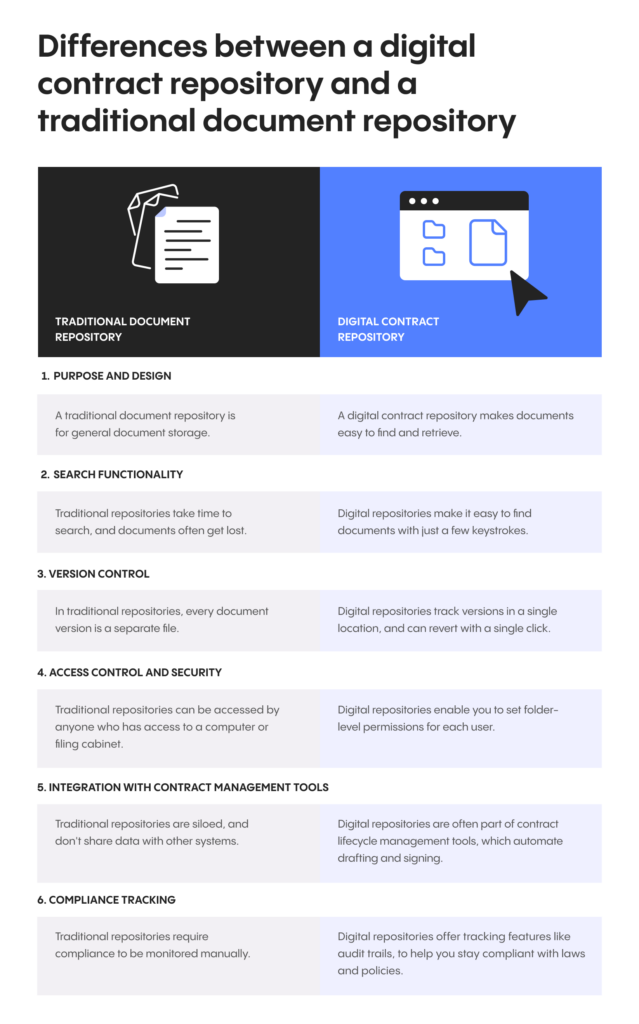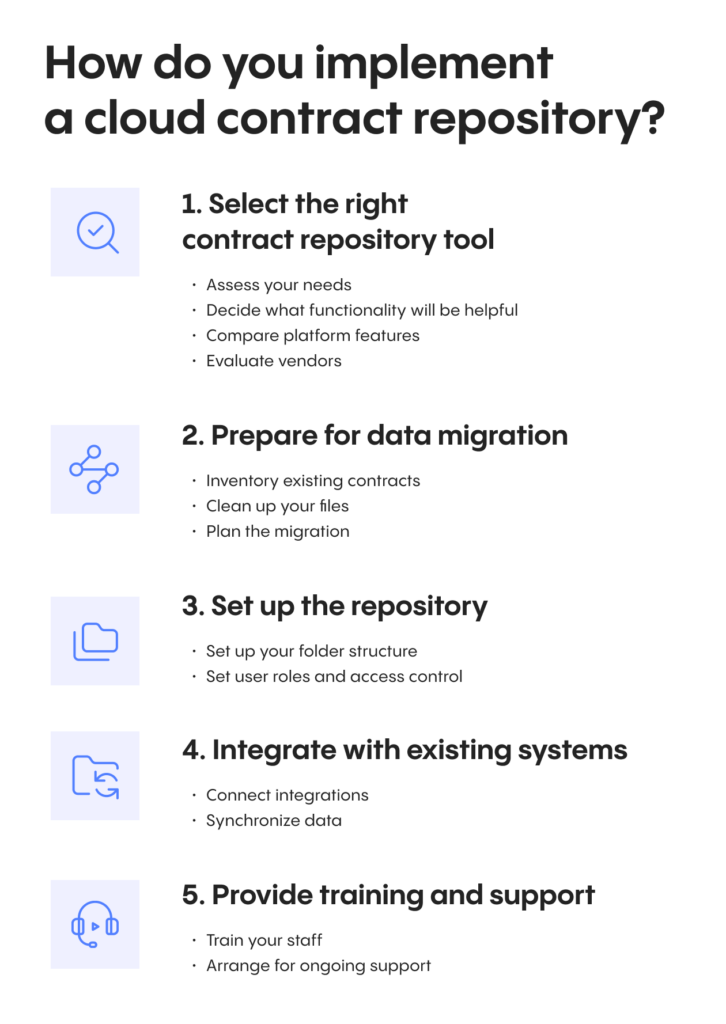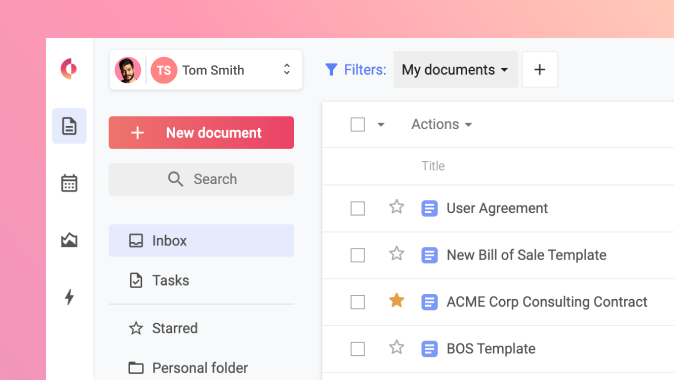Contract Repository: The Ultimate Guide
Table of contents
- What is a digital contract repository?
- What are the benefits of a digital contract repository?
- How do you implement a cloud contract repository?
- Managing a cloud contract repository
- Legal implications and compliance in contract repositories
- Security challenges and solutions in contract repositories
- Additional considerations with contract repositories
- Case study: Yates Construction
- Conclusion: A contract repository keeps your operations moving forward
-
About Concord
Effortless contract management, from drafting to e-signing and beyond. Book a live demo to see Concord in action.
Request demo
Keeping all your agreements in centralized contract repositories makes them much easier to track. A digital repository can also help you find archived agreements in seconds, with just a few keystrokes.
But what exactly is a contract repository? How do you create one, and how should you structure it so contracts are easy to find? That’s what we’ll cover here.
By the end of this guide, you’ll not only know what a contract repository is, but also how to implement and manage one of your own. Let’s dive in!
What is a digital contract repository?
A digital contract repository is an online tool for storing, managing, and tracking contracts in one place. It organizes all contract documents for a business —and it’s different from traditional paper repositories in six main ways.

Differences between a digital contract repository and a traditional document repository
- Purpose and design: While a traditional document repository is for general document storage, a digital contract repository is designed to keep documents organized, secure, and easy to find and retrieve.
- Search functionality: Digital contract repositories offer advanced search capabilities, allowing users to find contracts based on specific clauses, dates, parties involved, and other contract-specific criteria.
- Version control: Unlike traditional paper repositories, digital contract repositories provide robust version control, ensuring that only the most current version of a contract is accessed and used.
- Access control and security: Digital contract repositories typically have enhanced security features and more sophisticated access controls to protect sensitive contractual information.
- Integration with contract management tools: Digital repositories are often part of contract lifecycle management tools, which streamline tasks like contract creation, execution, and contract renewal.
- Compliance tracking: A digital contract repository can offer compliance tracking features such as audit trails, ensuring that contracts adhere to relevant laws, regulations, and company policies.
What are the benefits of a digital contract repository?
The benefits of a digital contract repository include better version control, secure storage, easier access to documents, and more efficient contract management. Below are more details on each of these key advantages.
Benefit 1: Contract version control
Automated version tracking can help keep your team on the same page, by making sure everyone is working on the same file.
- Ensures accuracy: Maintains the most current version of each contract, preventing confusion over outdated terms.
- Tracks changes: Easily tracks revisions and amendments, providing a clear history of contract modifications.
Benefit 2: Secure document storage
Digital contract repositories can encrypt sensitive data, protecting your private documents from prying eyes.
- Protects sensitive information: Employs advanced security measures to safeguard confidential contract details.
- Limits access: Allows role-based access control, ensuring only authorized personnel can view or edit contracts.
Benefit 3: Easy access to documents
A digital repository makes it much easier to find and access documents quickly, even if they were created years ago.
- Quick retrieval: Enables fast and efficient searching for specific contracts or clauses.
- Remote accessibility: Offers cloud-based access, allowing stakeholders to view contracts from anywhere, at any time.
Benefit 4: More efficient contract lifecycle management
Digital contract repositories make contract management faster and more efficient in a variety of ways.
- Streamlines processes: Automates many steps in the contract lifecycle, from creation to renewal, saving time and reducing manual errors.
- Enhances compliance: Helps in tracking compliance with internal policies and external regulations.
- Improves collaboration: Facilitates better collaboration among teams, ensuring all parties are aligned and informed.
- Data-driven insights: Provides valuable analytics and contract management reporting, aiding in strategic decision-making and contract optimizations.
Switching to a digital contract repository can significantly boost the efficiency of your contract management, transforming it from a cumbersome administrative task into a streamlined process.
By centralizing contract storage and management, you can enhance consistency, reduce risks, and strengthen overall contract governance.
How do you implement a cloud contract repository?

Implementing a cloud contract repository involves a series of strategic steps and best practices to ensure a smooth transition from traditional methods to cloud contract management. Here’s a step-by-step guide.
Step 1. Select the right contract repository tool
- Assess your needs: Determine your organization’s specific requirements for contract management.
- Decide what functionality will be helpful: Figure out if you just need a standalone contract repository, or a full-featured contract lifecycle management tool that will scale as your organization grows.
- Compare platform features: Look for features like ease of use, scalability, integration capabilities, and security standards.
- Evaluate vendors: Research and select a reputable vendor with a proven track record in cloud-based contract management solutions.
Step 2. Prepare for data migration
- Inventory existing contracts: Compile a comprehensive list of all existing contracts and related documents.
- Clean up your files: Make sure your contract files follow consistent naming conventions, and are filed in a coherent folder structure.
- Plan the migration: Develop a detailed plan for transferring data from the existing system to the new repository.
Step 3. Set up the repository
- Set up your folder structure: Customize the cloud contract repository‘s structure and categorization system to align with your business processes.
- Set user roles and access control: Establish user roles and permissions to control access to sensitive contract information.
Step 4. Integrate with existing systems
- Connect integrations: Set up and turn on integrations with existing systems like CRM, ERP, or other management tools.
- Synchronize data: Set up synchronization protocols for real-time data updates across integrated systems.
Step 5. Provide training and support
- Train your staff: Conduct comprehensive training for all users to familiarize them with the new system.
- Arrange for ongoing support: Arrange for ongoing technical support and updates from the vendor.
Quick tips for migrating to a contract repository
- Transition gradually: Consider a phased approach to migration to minimize disruptions.
- Keep stakeholders involved: Engage key stakeholders in the planning and implementation process for smoother adoption.
- Communicate regularly: Keep all parties informed about progress and changes to ensure transparency.
- Test and improve: Conduct thorough testing at each stage of the migration to catch and rectify issues early.
By following these steps and best practices, you can effectively set up a cloud contract repository — paving the way for more efficient, secure, and accessible contract management.
Managing a cloud contract repository
Effective management of a cloud contract repository is crucial for maximizing its benefits. Here are some document repository best practices to ensure efficient operation.
- Regularly audit and update: Regularly audit the repository to ensure all contracts are up-to-date and accurately reflected.
- Provide training and support: Provide ongoing training and support for users to fully utilize the repository’s features.
- Keep files organized: Use the repository’s organizational tools to categorize contracts for easier retrieval and tracking.
- Keep permissions up-to-date: Regularly review and adjust user access rights to maintain security and relevance.
- Integrate with other systems: Ensure seamless integration with other business systems for unified management.
- Monitor compliance: Utilize the repository’s features to monitor compliance with legal requirements and internal policies.
- Create a backup plan: Implement robust backup and recovery plans to protect against data loss.
- Review your analytics: Use analytics tools to track repository usage and performance for continuous improvement.
- Keep gathering feedback: Establish feedback channels for users to suggest improvements or report issues.
Using contract management software effectively for contract data organization and retrieval, coupled with a strong focus on ongoing security and compliance, ensures the repository remains a valuable asset in contract lifecycle management.
Legal implications and compliance in contract repositories
Contract repositories are crucial for ensuring legal and regulatory compliance. Understanding various legal considerations is essential. Here’s a list of key legal issues to be aware of, along with practical tips for using your contract repository to address each of them.
1. Data protection and privacy laws
When you become aware of updates to data protection laws like GDPR, HIPAA, and CCPA, pull up relevant contracts in your repository and double-check that they’re compliant with the changes.
2. Intellectual property rights
Periodically review contracts containing intellectual property details. Ensure they’re stored securely and only accessible to authorized personnel, safeguarding IP information effectively.
3. Electronic signature compliance
Stay updated with electronic signature laws such as the ESIGN Act or eIDAS. Regularly audit the electronic signature process in your repository for legal validity and maintain a comprehensive audit trail.
4. Renewal alerts
Set deadline alerts to alert you when different types of contracts reach their legally mandated retention periods. This will help in managing document lifecycles in compliance with legal requirements.
5. Audit trails and record keeping
Use a repository that automatically generates audit trails for each contract. Audit trails should track all modifications, approvals, and accesses — which will come in very handy during legal audits, and strengthen accountability overall.
6. Compliance with industry-specific regulations
Use your repository to periodically review contracts for adherence to industry-specific regulations like SOX or HIPAA. Update contract templates and clauses in the repository as regulations change.
7. Jurisdictional variances
Review contracts applicable in multiple jurisdictions, and double-check that they comply with the respective laws. Regularly review international contracts for any legal changes in the concerned jurisdictions.
8. Security standards and data breach protocols
Conduct routine security audits of your repository to ensure strong protection against unauthorized access. Establish and practice data breach response protocols in line with legal requirements.
When you follow these best practices will enhance the legal and regulatory compliance of your contract repository, you’ll be able to make sure it remains a reliable and secure asset in your contract management strategy.
How repositories aid in maintaining legal and regulatory compliance
- Centralized control: A repository helps you monitor your contractual compliance.
- Automated compliance checks: Repositories make it easy to flag non-compliant clauses or missing elements.
- Version control: Your repository will help keep your whole team aligned on using the latest, compliant contract versions.
- Accessibility for audits: With a repository, you can quickly access contracts in case of a compliance audit.
These tips can help in managing a contract repository, keeping your organization in compliance with legal and regulatory requirements. In particular, compliance can mitigate legal risks, enhancing your contract management integrity.
Security challenges and solutions in contract repositories
Effective security measures are vital for protecting contract repositories from various risks. Here’s a structured approach to address common security challenges and their solutions.
Challenge 1. Unauthorized access
Solution: Implement strict access control measures. Regularly audit user permissions to ensure only authorized personnel can access sensitive contract information. Use role-based access controls to limit exposure of sensitive data.
Challenge 2. Data breaches
Solution: Establish robust security protocols. Regularly update your cybersecurity measures and conduct penetration testing to identify vulnerabilities. Train employees on recognizing phishing attempts and other common attack vectors.
Challenge 3. Data corruption and loss
Solution: Implement consistent backup schedules and ensure data is stored in multiple, secure locations. Test your data recovery processes periodically to ensure they’re effective in the event of data loss.
Challenge 4. Compliance violations
Solution: Regularly review and update security measures to comply with data protection laws like GDPR, HIPAA, and CCPA. Conduct compliance audits to ensure all aspects of the repository meet legal standards.
Challenge 5. Insider threats
Solution: Monitor user activities and establish behavioral baselines. Use anomaly detection tools to alert administrators to unusual activities that could indicate insider threats.
Challenge 6. External attacks (e.g., hacking, malware)
Solution: Use advanced cybersecurity tools like firewalls, antivirus software, and intrusion detection systems. Regularly update these tools and conduct security training sessions for staff.
Challenge 7. Inadequate encryption and data protection
Solution: Make sure that all sensitive data, especially when transmitted over networks, is encrypted. Use strong encryption standards and regularly update your encryption protocols.
Challenge 8. Physical security breaches
Solution: If applicable, secure the physical locations where servers or backups are stored. Implement access controls, surveillance, and environmental protections (like fire suppression systems) in these areas.
Challenge 9. Obsolete technology and software
Solution: Regularly update all software, including the contract repository platform, to the latest versions. Stay informed about end-of-life announcements for software and plan upgrades accordingly.
By addressing these challenges with the outlined solutions and best practices, you can significantly enhance the security of your contract repository, safeguarding it against various internal and external threats.
Additional considerations with contract repositories
Beyond basic setup and document management, here are several additional factors to consider for maximizing the efficacy of your contract repository.
Role of contract management processes
- Streamlined workflows: Implementing efficient contract management processes enhances the repository’s utility, making contract creation, approval, and renewal smoother.
- Policy alignment: Aligning repository use with organizational policies ensures consistent contract handling and compliance.
- Regular process evaluation: Continuously evaluating and refining contract management processes keeps the repository relevant and effective.
Integration with other management solutions
- CRM and ERP Systems: Integrating the repository with customer relationship management (CRM) and enterprise resource planning (ERP) systems can provide a holistic view of business contracts and operational data.
- Collaboration tools: Linking with collaboration tools facilitates better communication and teamwork on contract-related tasks.
- Contract automation tools: Leveraging contract automation tools for routine tasks can significantly increase efficiency.
The future of digital contract storage and management
- Emerging technologies: The integration of blockchain, AI, and machine learning will further revolutionize contract storage and management, enhancing security and predictive analytics.
- Increased mobility and accessibility: Future developments will likely focus on improved mobile access and user-friendly interfaces for on-the-go contract management.
- Enhanced compliance tracking: Advancements in compliance tracking will make it easier for organizations to stay abreast of changing regulations and industry standards.
Understanding and leveraging these additional considerations can substantially enhance the effectiveness of a contract repository, ensuring it remains a dynamic and invaluable tool in the ever-evolving landscape of digital contract management.
To see exactly how these contract repository benefits play out in the real world, let’s take a look at a case study from one of Concord’s largest clients: a nationwide construction company.
Case study: Yates Construction
Yates Construction, a large company with 5,000 employees across 15 regional divisions, faced significant challenges in managing contracts for their numerous large-scale projects. The process of sending, revising, and signing contracts was laborious, with contracts scattered across email chains and susceptible to unauthorized edits by external contractors.
To address these challenges, Yates adopted Concord as their unified contract lifecycle management (CLM) solution. This transition marked a shift from a disorganized email-based system to a centralized, cloud-based contract repository.
How Yates Construction benefited from adopting a contract repository
Implementing Concord’s contract repository brought immediate and significant benefits to Yates Construction.
- Time and cost savings: The elimination of manual emailing and version control issues saved Yates thousands of dollars monthly in labor hours.
- Continuity in operations: When an employee had to leave suddenly, the team could seamlessly access and manage her contracts, ensuring uninterrupted workflow.
- Streamlined approval process: Concord’s approval workflow reduced contract signing timelines from weeks to hours, accelerating project initiation.
- Consistency across divisions: Standardized document workflows provided a consistent electronic signature experience across all regional offices.
Yates’s experience with Concord demonstrates the transformative impact of a well-implemented contract repository system. It highlights how such a system can streamline processes, enhance efficiency, and provide greater visibility and control over contract management across a large, diverse organization.
Conclusion: A contract repository keeps your operations moving forward
By centralizing contract storage, enhancing version control, and streamlining contract lifecycle management, a contract repository significantly boosts organizational efficiency and compliance.
Adopting and effectively managing a contract repository is not just a strategic move but a necessary next step in growth. It’s a crucial tool that’ll keep your organization competitive and agile in a world with an ever-growing number of documents.





